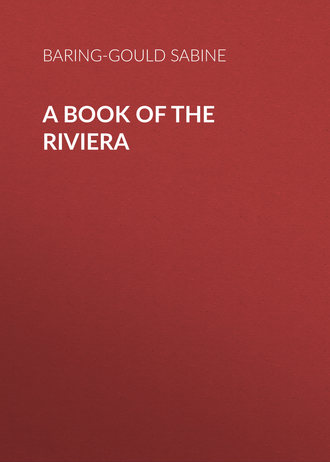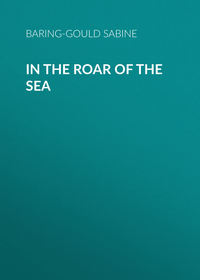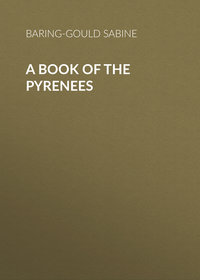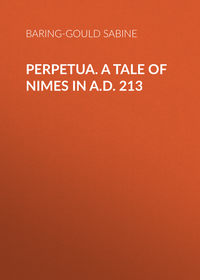 полная версия
полная версияA Book of The Riviera

S. Baring-Gould
A Book of The Riviera
“ON OLD HYEMS’ CHIN, AND ICY CROWN, AN ODOROUS CHAPLET OF SWEET SUMMER BUDS IS SET.”
Midsummer Night’s Dream, ii. 2.PREFACE
THIS little book has for its object to interest the many winter visitors to the Ligurian coast in the places that they see.
A consecutive history of Provence and Genoese Liguria was out of the question; it would be long and tedious. I have taken a few of the most prominent incidents in the history of the coast, and have given short biographies of interesting personages connected with it. The English visitor calls the entire coast – from Marseilles to Genoa – the Riviera; but the French distinguish their portion as the Côte d’Azur, and the Italians distinguish theirs as the Riviera di Ponente. I have not included the whole of this latter, so as not to make the book too bulky, but have stayed my pen at Savona.
CHAPTER I
PROVENCE
Montpellier and the Riviera compared – The discovery of the Riviera as a winter resort – A district full of historic interest – Geology of the coast – The flora – Exotics – The original limit of the sea – The formation of the craus– The Mistral – The olive and cypress – Les Alpines – The chalk formation – The Jura limestone – Eruptive rocks – The colouring of Provence – The towns and their narrow streets – Early history – The Phœnicians – Arrival of the Phocœans – The Roman province – Roman remains – Destruction of the theatre at Arles – Visigoths and Burgundians – The Saracens – When Provence was joined to France – Pagan customs linger on – Floral games – Carnival – The origin of the Fauxbourdon – How part-singing came into the service of the church – Reform in church music – Little Gothic architecture in Provence – Choirs at the west end at Grasse and VenceWHEN a gambler has become bankrupt at the tables of Monte Carlo, the Company that owns these tables furnish him with a railway ticket that will take him home, or to any distance he likes, the further the better, that he may hang or shoot himself anywhere else save in the gardens of the Casino. On much the same principle, at the beginning of last century, the physicians of England recommended their consumptive patients to go to Montpellier, where they might die out of sight, and not bring discredit on their doctors. As Murray well puts it: —
“It is difficult to understand how it came to be chosen by the physicians of the North as a retreat for consumptive patients, since nothing can be more trying to weak lungs than its variable climate, its blazing sunshine alternating with the piercingly cold blasts of the mistral. Though its sky be clear, its atmosphere is filled with dust, which must be hurtful to the lungs.”
The discovery of a better place, with equable temperature, and protection from the winds, was due to an accident.
In 1831, Lord Brougham, flying from the fogs and cold of England in winter, was on his way to Italy, the classic land of sunshine, when he was delayed on the French coast of the Mediterranean by the fussiness of the Sardinian police, which would not suffer him to pass the frontier without undergoing quarantine, lest he should be the means of introducing cholera into Piedmont. As he was obliged to remain for a considerable time on the coast, he spent it in rambling along the Gulf of Napoule. This was to him a veritable revelation. He found the sunshine, the climate, the flowers he was seeking at Naples where he then was, at Napoule. He went no farther; he bought an estate at Cannes, and there built for himself a winter residence. He talked about his discovery. It was written about in the papers. Eventually it was heard of by the physicians, and they ceased to recommend their patients to go to Montpellier, but rather to try Cannes. When Lord Brougham settled there, it was but a fishing village; in thirty years it was transformed; and from Cannes stretches a veritable rosary of winter resorts to Hyères on one side to Alassio on the other; as white grains threaded on the line from Marseilles to Genoa. As this chain of villas, hotels, casinos, and shops has sprung up so recently, the whole looks extremely modern, and devoid of historic interest. That it is not so, I hope to show. This modern fringe is but a fringe on an ancient garment; but a superficial sprinkling over beds of remote antiquity rich in story.
Sometimes it is but a glimpse we get – as at Antibes, where a monument was dug up dedicated to the manes of a little “boy from the North, aged twelve years, who danced and pleased” in the theatre. The name of the poor lad is not given; but what a picture does it present! Possibly, of a British child-slave sent to caper, with sore heart, before the Roman nobles and ladies – and who pined and died. But often we have more than a hint. The altar piece of the Burning Bush at Aix gives up an authentic portrait of easy-going King Réné, the luckless wearer of many crowns, and the possessor of not a single kingdom – Réné, the father of the still more luckless Margaret, wife of our Henry VI.
Among the Montagnes des Maures, on a height are the cisterns and foundations of the stronghold of the Saracens, their last stronghold on this side of the Pyrenees, whence they swept the country, burning and slaying, till dislodged in 972 by William, Count of Provence. Again, the house at Draguignan of Queen Joanna, recalls her tragic story; the wife of four husbands, the murderess of the first, she for whose delectation Boccaccio collected his merry, immoral tales; she, who sold Avignon to the Popes, and so brought about their migration from Rome, the Babylonish captivity of near a hundred years; she – strangled finally whilst at her prayers.
The Estérel, now clothed in forest, reminds us of how Charles V. advancing through Provence to claim it as his own, hampered by peasants in this group of mountains, set the forests on fire, and for weeks converted the district into one great sea of flame around the blood-red rocks.
Marseilles recalls the horrors of the Revolution, and the roar of that song, smelling of blood, to which it gave its name. At Toulon, Napoleon first drew attention to his military abilities; at S. Raphael he landed on his return from Egypt, on his way to Paris, to the 18th Brumaire, to the Consulate, to the Empire; and here also he embarked for Elba after the battle of Leipzig.
But leaving history, let us look at what Nature affords of interest. Geologically that coast is a great picture book of successions of deposits and of convulsions. There are to be found recent conglomerates, chalk, limestone, porphyry, new red sandstone, mica schist, granite. The Estérel porphyry is red as if on fire, seen in the evening sun. The mica schist of the Montagnes des Maures strews about its dust, so shining, so golden, that in 1792 a representative of the Department went up to Paris with a handful, to exhibit to the Convention as a token of the ineptitude of the Administration of Var, that trampled under foot treasures sufficient to defray the cost of a war against all the kings of the earth.
The masses of limestone are cleft with clus, gorges through which the rivers thunder, and foux springs of living water bursting out of the bowels of the mountains.
Consider what the variety of geologic formation implies: an almost infinite variety of plants; moreover, owing to the difference of altitudes, the flora reaches in a chromatic scale from the fringe of the Alpine snows to the burning sands by the seas. In one little commune, it is estimated that there are more varieties to be found than in the whole of Ireland.
But the visitor to the seaboard – the French Côte d’azur and the Italian Riviera – returns home after a winter sojourn there with his mind stored with pictures of palms, lemons, oranges, agaves, aloes, umbrella pines, eucalyptus, mimosa, carob-trees, and olives. This is the vegetation that characterises the Riviera, that distinguishes it from vegetation elsewhere; but, although these trees and shrubs abound, and do form a dominant feature in the scenery, yet every one of them is a foreign importation, and the indigenous plants must be sought in mountain districts, away from towns, and high-roads, and railways.
These strangers from Africa, Asia, Australia and South America have occupied the best land and the warmest corners, just as of old the Greek and Roman colonists shouldered out the native tribes, and forced them to withdraw amidst the mountains.
The traveller approaching the Riviera by the line from Lyons, after passing Valence, enters a valley that narrows, through which rolls the turbid flood of the Rhone. Presently the sides become steeper, higher, more rocky, and draw closer; on the right appears Viviers, dominated by its cathedral and tower, square below, octagonal above, and here the Rhone becomes more rapid as it enters the Robinet de Donzère, between calcareous rocks full of caves and rifts. Then, all at once, the line passes out of the rocky portal, and the traveller enters on another scene altogether, the vast triangular plain limited by the Alps on one side and the Cevennes on the other, and has the Mediterranean as its base. To this point at one time extended a mighty gulf, seventy miles from the present coast-line at the mouth of the Rhone. Against the friable limestone cliffs, the waves lapped and leaped. But at some unknown time a cataclysm occurred. The Alps were shaken, as we shake a tree to bring down its fruit, and the Rhone and the Durance, swollen to an enormous volume, rolled down masses of débris into this gulf and choked it. The Durance formed its own little crau along the north of the chain of the Alpines, and the Rhone the far larger crau of Arles, the pebbles of which all come from the Alps, in which the river takes it rise. But, in fact, the present craus represent but a small portion of the vast mass of rubbish brought down. They are just that part which in historic times was not overlaid with soil.
When this period was passed, the rivers relaxed their force, and repented of the waste they had made, and proceeded to chew into mud the pebbles they rolled along, and, rambling over the level stretches of rubble, to deposit upon it a fertilising epidermis. Then, in modern times, the engineers came and banked in the Rhone, to restrain its vagaries, so that now it pours its precious mud into the sea, and yearly projects its ugly muzzle further forwards. When we passed the rocky portal, we passed also from the climate of the North into that of the South, but not to that climate without hesitations. For the sun beating on the level land heats the pebble bed, so that the air above it quivers as over a lime-kiln, and, rising, is replaced by a rush of icy winds from the Alps. This downrush is the dreaded Mistral. It was a saying of old: —
“Parlement, Mistral, et DuranceSont les trois fléaux de Provence.”The Parliament is gone, but the Mistral still rages, and the Durance still overflows and devastates.
The plain, where cultivated, is lined and cross-lined as with Indian ink. These lines, and cross-lines, are formed of cypress, veritable walls of defence, thrown up against the wind. When the Mistral rages, they bow as whips, and the water of the lagoons is licked up and spat at the walls of the sparsely scattered villages. Here and there rises the olive, like smoke from a lowly cottage. It shrinks from the bite of the frost and the lash of the wind, and attains its proper height and vigour only as we near the sea; and is in the utmost luxuriance between Solliès Pont and Le Luc, growing on the rich new red sandstone, that skirts the Montagnes des Maures.
Presently we come on the lemon, the orange, glowing golden, oleanders in every gully, aloes (“God’s candelabra”), figs, mulberries, pines with outspread heads, like extended umbrellas, as the cypress represents one folded; cork trees, palms with tufted heads; all seen through an atmosphere of marvellous clearness, over-arched by a sky as blue as that of Italy, and with – as horizon – the deeper, the indigo blue, of the sea.
On leaving Arles, the train takes the bit between its teeth and races over the crau, straight as an arrow, between lines of cypresses. It is just possible to catch glimpses to the north, between the cypresses, of a chain of hills of opalescent hue. That chain, Les Alpines, gives its direction to the Durance. This river lent its aid to Brother Rhone to form this rubble plain, the Campus lapideus of the Romans, the modern crau. This was a desert over which the mirage alternated with the Mistral, till Adam de Craponne, in the sixteenth century, brought a canal from the Durance to water the stony land, and since then, little by little, the desert is being reclaimed. This vast stony plain was a puzzle to the ancients, and Æschylus, who flourished B.C. 472, tells us that Heracles, arriving at this plain to fight the Ligurians, and being without weapons, Heaven came to his aid and poured down great stones out of the sky against his foes. This is much like the account in Joshua of the battle against the Kings in the plain of Esdraelon.
At length, at Miramas, we escape from between the espalier cypresses and see that the distant chain has drawn nearer, that it has lost its mother-of-pearl tints, and has assumed a ghastly whiteness. Then we dash among these cretaceous rocks, desolate, forbidding and dead. They will attend us from Marseilles to Toulon.
The cretaceous sea bed, that once occupied so vast an area, has been lifted into downs and mountains, and stretched from Dorset and Wiltshire to Dover. We catch a glimpse of it at Amiens. A nodule that has defied erosion sustains the town and cathedral of Laon. It underlies the Champagne country. It asserts itself sullenly and resolutely in Provence, where it overlies the Jura limestone, and is almost indistinguishable from it at the junction, for it has the same inclination, the same fossils, and the same mineralogical constituents.
In England we are accustomed to the soft skin of thymy turf that covers the chalk on our downs. Of this there is none in Provence. The fierce sun forbids it. Consequently the rock is naked and cadaverously white, but scantily sprinkled over with stunted pines.
The Jura limestone is the great pièce de resistance in Provence: it is sweeter in colour than the chalk, ranging from cream white to buff and salmon; it has not the dead pallor of the chalk. Any one who has gone down the Cañon of the Tarn knows what exquisite gradations and harmonies of tone are to be found in Jura limestone. Here this formation stands up as a wall to the North, a mighty screen, sheltering the Riviera from the boreal winds. It rises precipitously to a plateau that is bald and desolate, but which is rent by ravines of great majesty and beauty, through which rush the waters from the snowy Alps. The chalk and the limestone are fissured, and allow the water flowing over their surface to filter down and issue forth in the valleys, rendering these fertile and green, whereas the plateaux are bare. The plateaux rise to the height of 3,000 or 4,500 feet.
The tract between the mountain wall of limestone and the sea is made up of a molass of rolled fragments of the rock in a paste of mud. This forms hills of considerable height, and this also is sawn through here and there by rills, or washed out by rivers.
Altogether different in character is the mass of the Montagnes des Maures, which is an uplifted body of granite and schist.
Altogether different again is the Estérel, a protruded region of red porphyry.
About these protruded masses may be seen the new red sandstone.
When we have mastered this – and it is simple enough to remember – we know the character of the geology from the mouths of the Rhone to Albenga.
“The colouring of Provence,” says Mr. Hammerton, “is pretty in spring, when the fields are still green and the mulberry trees are in leaf, and the dark cypress and grey olive are only graver notes in the brightness, while the desolation of the stony hills is prevented from becoming oppressive by the freshness of the foreground; but when the hot sun and the dry wind have scorched every remnant of verdure, when any grass that remains is merely ungathered hay, and you have nothing but flying dust and blinding light, then the great truth is borne in upon you that it is Rain which is the true colour magician, though he may veil himself in a vesture of grey cloud.”
In winter and early spring it is that the coast is enjoyable. In winter there is the evergreen of the palms, the olive, the ilex, the cork tree, the carob, the orange and lemon and myrtle. Indeed, in the Montagnes des Maures and in the Estérel, it is always spring.
The resident in winter can hardly understand the structure of the towns, with streets at widest nine feet, and the houses running up to five and six storeys; but this is due to necessity. The object is double: by making the streets so narrow, the sun is excluded, and the sun in Provence is not sought as with us in England; and secondly, these narrow thoroughfares induce a draught down them. In almost every town the contrast between the new and the old is most marked, for the occupants of the new town reside there for the winter only, and therefore court the sun; whereas the inhabitants of the old town dwell in it all the year round, and consequently endeavour to obtain all protection possible from the sun. But this shyness of basking in the sun was not the sole reason why the streets were made so narrow. The old towns and even villages were crowded within walls; a girdle of bulwark surrounded them, they had no space for expansion except upwards.
What Mr. Hammerton says of French towns applies especially to those of Provence: —
“France has an immense advantage over England in the better harmony between her cities and towns, and the country where they are placed. In England it rarely happens that a town adds to the beauty of a landscape; in France it often does so. In England there are many towns that are quite absolutely and hideously destructive of landscape beauty; in France there are very few. The consequence is that in France a lover of landscape does not feel that dislike to human interference which he so easily acquires in England, and which in some of our best writers, who feel most intensely and acutely, has become positive hatred and exasperation.”
It was fear of the Moors and the pirates of the Mediterranean which drove the inhabitants of the sea-coast to build their towns on the rocks, high uplifted, walled about and dominated by towers.
I will now give a hasty sketch of the early history of Provence – so far as goes to explain the nature of its population.
The earliest occupants of the seaboard named in history are the Ligurians. The Gulf of Lyons takes its name from them, in a contracted form. Who these Ligurians were, to what stock they belonged, is not known; but as there are megalithic monuments in the country, covered avenues at Castelet, near Arles, dolmens at Draguignan and Saint Vallier, a menhir at Cabasse, we may perhaps conclude with some probability that they were a branch of that great Ivernian race which has covered all Western Europe with these mysterious remains. At an early period, the Phœnicians established trading depôts at Marseilles, Nice, and elsewhere along the coast. Monaco was dedicated to their god, Melkarth, whose equivalent was the Greek Heracles, the Roman Hercules. The story of Heracles fighting the gigantic Ligurians on the crau, assisted by Zeus pouring down a hail of pebbles from heaven, is merely a fabulous rendering of the historic fact that the Phœnician settlers had to fight the Ligurians, represented as giants, not because they were of monstrous size, but because of their huge stone monuments.
The Phœnicians drew a belt of colonies and trading stations along the Mediterranean, and were masters of the commerce. The tin of Britain, the amber of the Baltic, passed through their hands, and their great emporium was Marseilles. It was they who constructed the Heraclean Road, afterwards restored and regulated by the Romans, that connected all their settlements from the Italian frontier to the Straits of Gibraltar. They have left traces of their sojourn in place names; in their time, Saint Gilles, then Heraclea, was a port at the mouth of the Rhone; now it is thirty miles inland. Herculea Caccabaria, now Saint Tropez, recalls Kaccabe, the earliest name of Carthage. One of the islets outside the harbour of Marseilles bore the name of Phœnice.
This energetic people conveyed the ivory of Africa to Europe, worked the lead mines of the Eastern Pyrenees, and sent the coral and purple of the Mediterranean and the bronze of the Po basin over Northern Europe. The prosperity of Tyre depended on its trade.
“Inventors of alphabetical writing, of calculation, and of astronomy, essential to them in their distant navigations, skilful architects, gold-workers, jewellers, engravers, weavers, dyers, miners, founders, glass-workers, coiners, past-masters of all industries, wonderful sailors, intrepid tradesmen, the Phœnicians, by their incomparable activity, held the old world in their grip; and from the Persian Gulf to the Isles of Britain, either by their caravans or by their ships, were everywhere present as buyers or sellers.”1
Archæological discoveries come to substantiate the conclusions arrived at from scanty allusions by the ancients. The Carthaginians had succeeded to the trade of Tyre; but Carthage was a daughter of Tyre. At Marseilles have been found forty-seven little stone chapels or shrines of Melkarth, seated under an arch, either with his hands raised, sustaining the arch, or with them resting on his knees; and these are identical in character with others found at Tyre, Sidon, and Carthage. Nor is this all. An inscription has been unearthed, also at Marseilles, containing a veritable Levitical code for the worship of Baal, regulating the emoluments of his priests.
In the year B.C. 542 a fleet of Phocœans came from Asia Minor, flying from the Medes; and the citizens of Phocœa, abandoning their ancient homes, settled along the coast of the Riviera. Arles, Marseilles, Nice – all the towns became Greek. It was they who introduced into the land of their adoption the vine and the olive. They acquired the trade of the Mediterranean after the fall of Carthage, B.C. 146.
The Greeks of the coast kept on good terms with Rome. They it was who warned Rome of the approach of Hannibal; and when the Ambrons and Teutons poured down a mighty host with purpose to devastate Italy, the Phocœan city of Marseilles furnished Marius with a contingent, and provisioned his camp at the junction of the Durance with the Rhone.
The Romans were desirous of maintaining good relations with the Greek colonies, and when the native Ligurians menaced Nice and Antibes, they sent an army to their aid, and having defeated the barbarians, gave up the conquered territory to the Greeks.
In B.C. 125, Lucius Sextius Calvinus attacked the native tribes in their fastness, defeated them, and founded the town of Aquæ Sextiæ, about the hot springs that rise there – now Aix. The Ligurians were driven to the mountains and not suffered to approach the sea coast, which was handed over entirely to the Greeks of Marseilles.
So highly stood the credit of Marseilles, that when, after the conclusion of the Asiatic War, the Senate of Rome had decreed the destruction of Phocœa, they listened to a deputation from Marseilles, pleading for the mother city, and revoked the sentence. Meanwhile, the Gauls had been pressing south, and the unfortunate Ligurians, limited to the stony plateaux and the slopes of the Alps, were nipped between them and the Greeks and Romans along the coast. They made terms with the Gauls and formed a Celto-Ligurian league. They were defeated, and the Senate of Rome decreed the annexation of all the territory from the Rhone to the Alps, to constitute thereof a province. Thenceforth the cities and slopes of the coast became places of residence for wealthy Romans, who had there villas and gardens. The towns were supplied with amphitheatres and baths. Theatres they possessed before, under the Greeks; but the brutal pleasures of the slaughter of men was an introduction by the Romans. The remains of these structures at Nîmes, Arles, Fréjus, Cimiez, testify to the crowds that must have delighted in these horrible spectacles. That of Nîmes would contain from 17,000 to 23,000 spectators; that of Arles 25,000; that of Fréjus an equal number.









